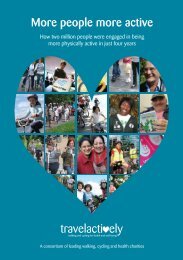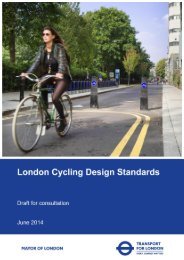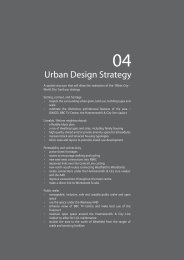Travel in London Travel in London
travel-in-london-report-8
travel-in-london-report-8
Create successful ePaper yourself
Turn your PDF publications into a flip-book with our unique Google optimized e-Paper software.
9. <strong>London</strong>’s air quality and greenhouse gas emissions and transport and public health<br />
from all sources, and the reductions to be achieved from transport would not<br />
necessarily be exactly proportionate to the overall 60 per cent reduction, ma<strong>in</strong>ly<br />
because the cost-effectiveness of reduction <strong>in</strong>itiatives varies between different<br />
economic sectors.<br />
The CCMES analysis broke down the contributions to the 60 per cent target by<br />
sector as follows (these are reductions by 2025 from 1990 levels):<br />
• Industrial and Commercial 71 per cent reduction (14.07 MtCO 2 )<br />
• Domestic 53 per cent (8.45 MtCO 2 )<br />
• Transport 48 per cent (4.52 MtCO 2 )<br />
CO 2 emissions from transport <strong>in</strong> 2013<br />
Interim figures from the <strong>London</strong> Energy and Greenhouse Gas Inventory (LEGGI)<br />
showed that emissions from transport were 8.67 MtCO 2 <strong>in</strong> 2013, and accounted<br />
for 22 per cent of <strong>London</strong>’s CO 2 emissions. This is a low proportion when<br />
compared to the national average of 27 percent <strong>in</strong> 2012. Note that these estimates<br />
will be updated on the basis of the new <strong>London</strong> emissions <strong>in</strong>ventories, as described<br />
<strong>in</strong> the follow<strong>in</strong>g sections. Nevertheless, they do provide a basis for better<br />
understand<strong>in</strong>g the challenge that the Mayor’s CO 2 reduction target presents <strong>in</strong> the<br />
context of a rapidly grow<strong>in</strong>g city.<br />
TfL’s Health, Safety and Environment Report 2013-14 sets out medium-term<br />
trends for CO 2 emissions from the ma<strong>in</strong> public transport modes <strong>in</strong> <strong>London</strong>. Carbon<br />
dioxide reduction targets are framed <strong>in</strong> terms of absolute tonnages of emissions,<br />
however, <strong>London</strong>’s rapidly grow<strong>in</strong>g population, and the need to provide enhanced<br />
public transport to accommodate this and provide for future economic growth,<br />
mean that steps to reduce CO 2 emissions are more appropriately assessed on a<br />
normalised (per passenger kilometre) basis. TfL’s target is to reduce normalised<br />
CO 2 emissions from the ma<strong>in</strong> public transport modes, as measured <strong>in</strong> grams CO 2 e<br />
(carbon dioxide equivalent) per passenger kilometre, by 20 per cent <strong>in</strong> 2017/18 as<br />
measured aga<strong>in</strong>st a 2005/06 basel<strong>in</strong>e. Figure 9.3 shows progress towards this target<br />
to be broadly on track. However, the equivalent pace of reduction <strong>in</strong> absolute<br />
tonnages falls short of the wider Mayor’s reduction target.<br />
168 <strong>Travel</strong> <strong>in</strong> <strong>London</strong>, Report 8








